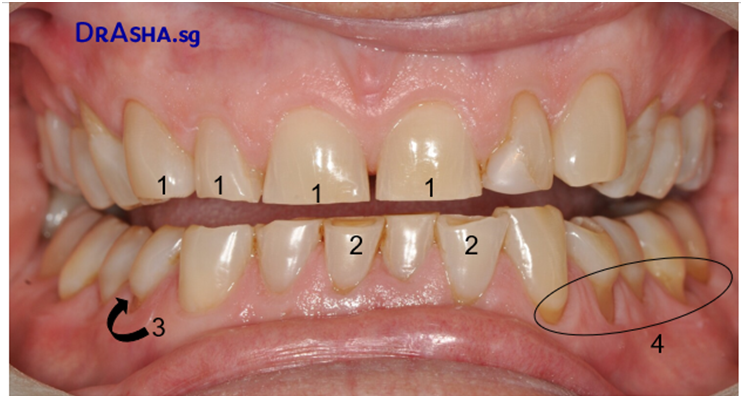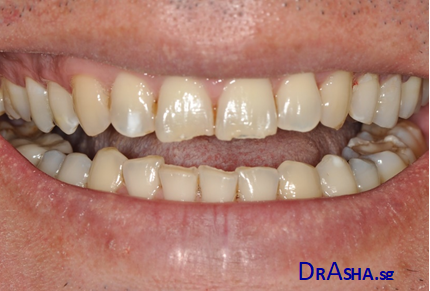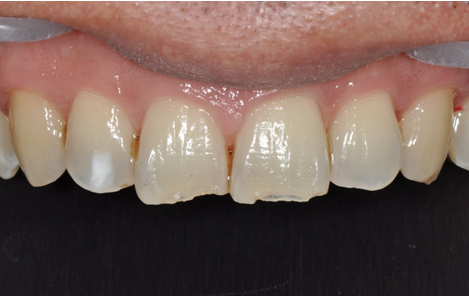Bruxism – Teeth Grinding, Clenching or Gritting
Table of Contents
What is Bruxism?
Bruxism is a condition in which you unconsciously grind, clench or grit your teeth. It is not related to any eating habits like crushing ice or bones or nuts. Indeed, it is not related to how or what you eat.
Bruxism can be observed in people when they are awake – “awake bruxism”. Clenching is more common in “awake bruxism” and may be due to emotions such as anxiety, stress, anger, frustration, or tension. Or it may be a habit during deep concentration.
Sleep-related bruxism involves repetitive jaw-muscle activity during sleep. It is considered a sleep-related movement disorder. Grinding is more commonly seen in sleep bruxism.

The teeth of a person with long-standing bruxism
What causes Bruxism?
Scientists do not know exactly what causes bruxism
There are probably many factors that could lead to this condition.
1. State of mind or Stress
Stress is a reaction to a stimulus that disturbs our physical or mental equilibrium creating unresolved emotions such as frustration, anger, competitiveness, aggressiveness, anxiety, tension, hyperactive personality or unresolved conflict. Suppression of feelings can also cause undue stress. Stressful periods such as examinations, family bereavement, divorce or marriage, relocating, overworking, excessive worrying or any other situation that can add extra pressure can intensify bruxism.
2. Personality type.
Personalities that are competitive or hyperactive can increase risk of bruxism.
3. Familial Tendency
If other members of your family have bruxism, it increases the chance of you having it
4. Drugs
Alcohol, tobacco, coffee and other caffeine-containing drinks; stimulants in drugs such as ecstasy, cocaine, and heroine increase bruxism. With regular use, these drugs can promote bruxism leading to severe attrition in a short amount of time.
5. Sleep Disorders
It is known that people who clench or grind their teeth during sleep are more likely to snore or have obstructive sleep apnea.
6. Bad Bite or Poorly aligned teeth
A tooth or teeth that are not in alignment may cause interference when the upper and lower teeth come together. This interference may cause grinding in an attempt to flatten the tooth or teeth that are in the way.
7. Medical Conditions
Conditions like ADHD (Attention Deficit/Hyperactivity Disorder), Parkinson’s Disease or long-term medicines
Why is Bruxism a concern?
In some people bruxism may occur frequently or strongly enough to cause damage to the teeth, headaches or facial pain
What are the Consequences of Bruxism?
• Attrition
Due to the friction caused by the grinding or even frequent clenching, there is wear or loss of tooth substance. This is visible as flattening of the teeth.
• Colour changes in the teeth
Teeth can look more yellow. When teeth get attrited, the outer layer of enamel wear out and expose the inner yellow layer of dentine. With time, the dentine can get further stained by tobacco or food stains or early decay
• Sensitivity
- Exposed dentine can present sensitivity to cold or sour food
- Dentine is softer than enamel and more prone to decay which may present sensitivity in its early stages
- The force of bruxism may overload some teeth and cause them to feel sore
- The repeated, strong forces exerted by bruxism may cause cracks in the teeth which may also present as sensitivity.
• Gum recession
The stress and strain caused by bruxism can cause tissue breakdown – especially in those who already have gum disease.
• Notches on the teeth near the gum line (abfractions)
This is caused by flexure of the tooth during grinding. Teeth are not designed to flex or bend. Tooth structure deteriorates at the areas of bending, just above the gum line. Abfractions are visible as clean, “v”-shaped defects on the tooth. These can be sensitive to cold water or ice-creams.

The Effects of long-term Bruxism
2 – The enamel has worn out revealing the yellow dentine
3 – Distinct V-shaped notches just above the gums
4 – Gum recession around several teeth
• Mobility of teeth
With bruxing, the teeth are forcefully rocked back and forth in the socket, which can cause temporary mobility, progressing to possible permanent mobility.
• Bony outgrowths
With excess strain and tension placed on the teeth and jaws, the body’s defense is to produce more or extra bone to support the teeth. These can appear as hard bulges or ridges on the bone supporting the teeth.
• Chipped teeth and fillings
As bruxism occurs unconsciously, during sleep, there is no active protective feedback mechanism to limit the amount of force exerted when clenching. Thus, during sleep, the amount of force exerted can be several times more than normal chewing forces. Hence, it is common for bruxers to chip or break their teeth or fillings.

This long-standing bruxer has chipped or broken the edges of his upper front teeth. The lower front teeth show flattened edges. Many of the back teeth have had to have crowns to cover the damage done to them.

Close-up of the upper front teeth to show how the edges of the teeth have become thin and several parts have chipped off.
• Cracked or fractured teeth
It is possible for teeth to crack vertically from the crown right down to the root. Such cracks may not be due to a one-off event but be the end result of repeated or cumulative forces. If a full vertical fracture happens, there may be no option but to remove the tooth.
• Prominent facial muscles
The masseter muscle that brings the jaws together is one of the strongest muscles in the body. Regular, repeated “work-outs” of this muscle during bruxism will result in this muscle
• Facial pain
The muscles used in grinding can become sore or stiff. Some bruxers can experience headaches, jaw aches or soreness of the neck and shoulders. This webpage gives a nice 3-D animation of the muscles used in grinding.
• Jaw Joint Discomfort
The junction of the lower jaw to the base of the skull, just in front of the ears, is termed the Tempero-Mandibular Joint (TMJ) This joint can get worn down by the repeated overloading from bruxism. The joint can become painful, or pose difficulties in opening wide. There might be clicking of the joint or locking. Some people might complain of pain from the ears, even though the problem is from the joint.
How can Bruxism be Treated?
As there are several possible causes for bruxism, treatment varies according to the cause, the frequency and severity of the condition. Treatment could involve several of the following:
• Holistic Therapy
If stress, anxiety or personality appears to be the cause, treatment may involve counselling, psychotherapy or relaxation techniques like meditation.
• Sleep Hygiene
This refers to habits and practices that are conducive to sleeping well on a regular basis. Recommendations include gentle exercise in the evening, avoiding stimulants like caffeine or alcohol; “winding down” rituals before sleep like a warm bath, meditation; sleeping in a dark, cool room devoid of lights from computers or phones.
• Muscle Relaxants
Episodes of acute muscle pain can be relieved with short-term muscle relaxants
Studies have found that people with the medical condition of obstructive sleep apnoea also exhibit bruxism. It is necessary to consult a physician to eliminate this possible condition. Treatment for OSA will often resolve the bruxism.
• Guards
These are custom-made,removable dental appliances that comfortably fit over your teeth to prevent damage to the teeth, fillings, or other dental work like crowns and implants.
In addition, guards have sufficient thickness to keep the upper and lower teeth apart so the muscles of the jaws cannot fully contract. This helps to relax the facial muscles.
There are different designs and materials used, some are hard acrylic, others are soft and flexible.
• Behaviour modification
This can be helpful in awake bruxism. Awareness is built around how the jaws and teeth should be kept apart and how the tongue should be positioned at rest.
• Align the Teeth
Teeth need to come together properly to function in a healthy manner. When irregularities cause interferences in the way teeth meet, the individual may attempt to “grind it out of the way”. Aligning the teeth (with braces or aligners) e.g. correcting deeply overlapping front teeth, can help to reduce the tendency to brux.
• Botox Injections
Botox weakens the masseter muscle (the main chewing muscle) enough to reduce the effects of grinding and clenching, but not so much as to prevent proper use of the muscle
• Alternative Medicine
For example Acupuncture or Osteopathic massage to relieve facial pain.
Bruxism is Common
A 2013 review of the scientific literature reported in the Journal of Orofacial Pain that the prevalence of awake bruxism varied from 22% to 31%. The prevalence of sleep bruxism was found to be more consistently around 13%
So, if you are grinding your teeth, you should be concerned with two things:
- Protecting your teeth from the strong vertical forces of grinding which can cause them to break, crack, become sensitive, cause you pain, prematurely yellow, and cause your gums to recede.
- You may have sleep apnea and should consider getting tested for this potentially life-threatening condition.
Early diagnosis and treatment are essential to prevent extensive – and possibly irreparable – damage.
